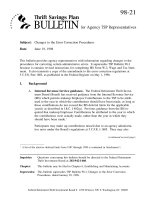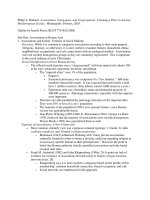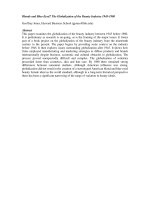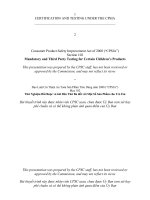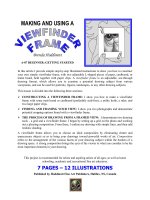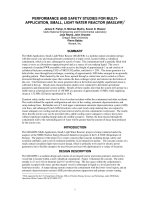Tài liệu Blonde and Blue eyed? The Globalization of the Beauty Industry - Geoff Jones for Von Gremp doc
Bạn đang xem bản rút gọn của tài liệu. Xem và tải ngay bản đầy đủ của tài liệu tại đây (205.54 KB, 61 trang )
Blonde and Blue-Eyed? The Globalization of the Beauty Industry 1945-1980
Geoffrey Jones, Harvard Business School ()
Abstract
This paper examines the globalization of the beauty industry between 1945 before 1980.
It is preliminary as research is on-going, as is the framing of the major issues. It forms
part of a book project on the globalization of the beauty industry from the nineteenth
century to the present. The paper begins by providing some context on the industry
before 1945. It then explores issues surrounding globalization after 1945. It shows how
firms employed manufacturing and marketing strategies to diffuse products and brands
internationally despite business, economic and cultural obstacles to globalization. The
process proved unexpectedly difficult and complex. The globalization of toiletries
proceeded faster than cosmetics, skin and hair care. By 1980 there remained strong
differences between consumer markets. Although American influence was strong,
globalization did not result in the creation of a stereotyped American blond and blue-eyed
beauty female ideal as the world standard, although in a long-term historical perspective
there has been a significant narrowing of the range of variation in beauty ideals.
2
Blonde and Blue-Eyed? The Globalization of the Beauty Industry 1945-1980
1
There is an enormous literature on globalization, and quite a strong literature on its
historical development. Yet, as Mauro Guillen noted some years back, the literature
remains highly contested (or else simply inconclusive) for all the “big” issues: what
globalization really is; what is new and what is not; what drives it and what stops it;
whether it undermines nation states; and whether it homogenizes cultures.
2
The history of
the globalization of the beauty industry provides insights on several of those issues, which
will be explored here.
It has to be observed that the historical development of today’s $230 billion global
beauty industry is poorly understood. The United States is the only country where the
industry has generated substantial historical research.
3
The literature on other countries,
even France, is fragmentary. The scarcity of the business, economic and social history
literature is surprising. On the one hand, the story might be considered just a subset of
consumer products in general. It certainly followed the familiar trajectory from
commercialization in the nineteenth century, followed by transition from being composed
of numerous small enterprises which sold products for their immediate localities to one in
which “global brands” sold by a small number of large corporations could be found
worldwide. On the other hand, the beauty industry has a number of distinctive
characteristics which make it of unusual interest, including that it appeared relatively late,
that many of its products were marketed to women, that it became characterized by large
advertising budgets, that it spanned the health/science and aesthetics/beauty arenas, that
demand was shaped by deep-seated cultural and societal norms, and that its products
affected – in an intimate fashion – how individuals perceive themselves and others. It holds
a particular significance in that context given the compelling research in a number of social
3
sciences concerning the “beauty premium,” which has explored how physical
attractiveness, which the products of the beauty industry claim to enhance, exercise a major
impact on individual lifestyles, ranging from the ability to attract sexual partners to lifetime
career opportunities and earnings.
4
Historical studies of the beauty industry are handicapped by definitional issues.
Broadly the industry includes products applied to the human body to keep it clean and
make it look attractive. Today it encompasses bath and shower products, such as toilet
soap; deodorants; dental, hair and skin care products; color cosmetics (including facial and
eye make-up, lip and nail products); fragrances; men’s grooming products, including
shaving creams; and baby care products. “Beauty” is now treated as a single industry;
there are listings of the largest firms and their market shares.
5
Historically, there were
major differences between product categories, which appeared at different chronological
periods, and differ widely in terms of production economics and distribution channels. A
distinction was often made between “toiletries,” such as toothpaste and shampoo, and
cosmetics and fragrances. At various times the industry was known as “toilet preparations”
or “personal care.” In many countries toilet soap was placed in a different industrial
classification.
6
There are additional definitional issues posed by the industry’s porous
borders with such services as beauty salons and cosmetic surgery. The upshot is that
compilation of even descriptive statistics about the historical development of the global
beauty industry presents enormous challenges.
My current study is organized around three broad questions.
• why and how did this industry move from local to global
• why and how did today’s global giants emerge
• what have been the implications for people worldwide
4
However these broad questions open up further issues. First, assuming “attractive” features
are found worldwide, why did the beauty industry become associated with certain features
rather than others, and just a few geographical locations (essentially Paris and New York)
become global beauty capitals? Second, to what extent has globalization led to
homogeneity? Third, is this an industry which must be seen as almost the epitome of
manipulative capitalism, more especially towards female consumers subjected to an
obsession with physical perfection which, as argued by Naomi Wolf and a long American
feminist tradition preceding her, trapped women in an endless spiral of hope, self-
consciousness and self-hatred.
7
The Beauty Industry before 1945
There was a fundamental contrast between the traditional uses of beauty products,
which have been used by at least the elites of almost every recorded human society, with
the emergence of the modern commercial beauty industry in the nineteenth century.
Although the origins of the industry lay in age-old products and practices, advances in
chemistry made possible the emergence of the modern perfume and soap industries, as
well as the factory production of creams, hair dyes and shampoos. Further technological
advances made possible toothpaste tubes, and advertising in magazines. The
transformation of transport and communications technologies over the course of the
century enabled the building of national markets.
The beauty industry was shaped by entrepreneurs who figured out ways to relate
such technological advances to the human desire to be attractive. By 1914 many of the
drivers of competitive success in the industry had been invented. Although fragrances,
soaps and other products carried, to a greater or less extent functional benefits, the
entrepreneurial pioneers of the industry had identified that the key to building successful
businesses lay in developing emotional benefits through branding. They created brands
5
which delighted consumers through their associations with fashionable cities, with
romantic images, and through stressing their natural ingredients which would make their
consumers healthy. They were also well advanced on segmenting markets, by price,
function, and brand positioning. The emergent industry made full use of contemporary
assumptions and ideals. Beauty brands offered the social status to which many aspired.
They became symbols of the superiority of the Western world; their use in the United
States became a rite of passage for the unwashed hordes from southern and eastern
Europe seeking to become Americans.
By 1914 entrepreneurs were also well advanced in both in creating and
understanding the importance of distribution channels. For premium fragrances,
cosmetics and toiletries, it was already understood that it was essential to have shops and
salons in the right location in the world’s global cities. The industry was either a pioneer
or an early adapter of mail order and direct sales, celebrity endorsement and testimonials.
The modern beauty industry developed in three overlapping stages. Stage 1 made
products which dealt with smell. Fragrances and soap were the two product categories
which developed first. France was enormously important in fragrances, while the United
States and Britain became early enthusiasts for using soap to become “clean”.
8
Urbanization resulted in growing stench and infectious diseases, which probably lay
behind the new desires to identify and classify smells, combined with a sudden urgency
to suppress unwanted odors, which emerged from the mid-eighteenth century.
9
Stage 2, which was well-advanced by the new century, was focused on
appearance. As flickering candlelight gave way to gas and electricity, and mirrors were
improved, people had unprecedented opportunities to look at themselves. The
commercial development of photography from the 1880s intensified visual awareness and
may have stimulated interest in using cosmetics.
10
Advances in printing enabled the
6
publication of illustrated magazines on a large scale, and mass circulation female fashion
magazines emerged in the last decades of the century.
11
This stimulated the market for
skin creams, and to a much lesser extent, cosmetics, which claimed to affect appearance,
typically by restoring natural features.
Stage 3 involved products which transformed appearance, by lipstick, mascara,
hair dyes, etc. Many such products were available by 1900, often in forms which were
not very user-friendly and sometimes not safe, but their use was constrained by moral
objections to “face painting” and so because of associations with prostitution or actors.
Beyond such urban dens of immorality as Paris, London and New York, demand was
limited. These products faced, in language dear to the hearts of sociologists, a major
challenge gaining legitimacy. This was overcome, at different rates in different societies,
after 1914. The growing use of transformational beauty products co-incided with a wider
trend which, as the French historian Delbourg-Delphis has argued, was manifested in a
growing confidence that human beings could take control, and shape and improve their
bodies, by exercise, diet and even surgery.
12
In many societies during the interwar years,
and sometimes earlier, there was a growth in people taking exercise, and a concern for
changing body shapes, although the manifestations were often strikingly different.
The size of the global industry may have reached $100 million in 1914. There was
also a supporting nexus of fashion magazines and, in several large cosmopolitan Western
cities, beauty salons, in place. There were significant levels of entrepreneurial activity
and innovation spread over several countries. France and its firms were firmly established
as the benchmark of fashion and sophistication. The United States was already the largest
single market, and its firms were well-advanced in mass marketing. Germany and Britain
had many creative and innovative firms, but neither country had established itself as
representing a global beauty ideal. Even Japan and Russia had significant businesses
7
supplying their domestic markets. The industry was in some aspects born global.
Entrepreneurs were often immigrants. Fashions spread between Western countries. There
was significant international trade in perfumes and toiletries.
Although the initial categories to achieve scale –toiletries – were either sold to both
genders or to sometimes just men, several leading soap brands had already transitioned to
an emphasis on feminine beauty by 1914. The importance of female consumers was
much greater in fragrances, and even more so in cosmetics. Women were also successful
entrepreneurs in cosmetics and hair care products, and many thousands worked in beauty
salons or as direct sales agents.
In 1914 beauty remained an industry which served affluent people in rich countries.
For most of the world’s population, even soap was a luxury. One estimate suggests that
only 20 per cent of Americans used any toilet preparation or cosmetic in 1916.
13
The global
beauty industry was “democratized” during the three decades after 1914. Luxuries became
necessities. The use of soap and other toiletries for cleaning and hygiene became almost
universal in developed countries. Smelling badly meant social disgrace, but using soap was
firmly established as being about a lot more than not smelling: Hollywood film stars had
their favorite brands, which could – their advertising campaigns asserted - make every
women beautiful. In many Western countries the regular use by women of color cosmetics,
hair dyes and other transformational products beauty products no longer carried
connotations of immorality, and consumption spread far beyond a few fashionable
European and American cities. At the outbreak of the Pacific War in 1941, the US
government declared the production of lipstick a wartime necessity.
14
By 1948 perhaps
90% of American women used lipstick.
15
However the democratization of beauty was not
confined to rising consumption. A fast growth of beauty salons and the spread of beauty
pageants contributed to making beauty part of everyday life for many people.
8
There were multiple drivers behind the growth of the beauty industry during these
decades. The world wars introduced millions of soldiers to the importance of hygiene,
eroded societal inhibitions about the use of cosmetics, and diffused practices and products.
Although the industry’s longer-term growth was a product of rising discretionary incomes
and urbanization, the Great Depression encouraged the creation of cheaper and more
accessible products. Firms engaged in huge educational efforts, whether to salon employers
in American towns or schoolchildren in rural Japan, to show people how to use their
products as the first step to persuading them to use them.
By the interwar years the United States was as firmly established as the home of
democratic beauty as France was the home of haute couture. In the United States, the social
pressure to be hygienic was enormous. It was the only country to have Cleanliness
Institute. American firms were foremost in asserting the transformational claims of the
industry. They and their advertising agencies led the world in market research and mass
marketing.
Yet the democratization of the beauty industry had striking limitations. Beauty had
borders which reflected prevailing societal and ideological assumptions. In the United
States, the mainstream beauty companies had little interest in non-White consumers, beauty
pageants excluded them, and ethnic groups with the “wrong” shaped noses created a
demand for cosmetic surgery.
16
In many different contexts, and not merely the extreme
cases of Nazi Germany and Imperial Japan, beauty was defined in a particular ethnic and
ideological fashion. The beauty companies were not the originators of such ideologies, but
they found them convenient marketing tools, and very rarely contested them.
In terms of industry structure, there were three distinctive types of firm in the
industry before 1945. First, there were the “soapers” whose volume business was laundry
soap, but also sold some toilet soap, dental products, men’s shaving, and baby products,
9
categories which could be exploited by mass marketing and mass production. In 1945
Procter & Gamble’s small beauty business remained largely toilet soap. The firm launched
the Camay beauty bar in 1926. Colgate-Palmolive, created by merger in 1927, also built a
large toothpaste business. Unilever, created in 1930 as Europe’s largest firm by the merger
of Lever Brothers and Margarine Union of the Netherlands, sold toilet soap, toothpaste, and
perfumery as a small part of its overall business, which was primarily laundry soap and
edible fats.
Secondly, pharmaceutical companies, especially for Over The Counter (OTC)
markets, manufactured dental products, toothpaste and some cosmetics. In the United
States, Lehn & Fink sold toothpaste and owned the Dorothy Gray brand of cosmetics. Vick
Chemical, whose largest business was its famous vapor rub, acquired a man’s toiletries and
the Prince Matchabelli cosmetics businesses in 1941. Bristol-Myers sold its original
pharmaceutical business during the interwar years, and devoted itself entirely to its
specialties, including toothpaste – it launched the Ipana brand in 1916 – and toiletries,
before becoming a large penicillin manufacturer during the 1940s. British-based Beecham,
a long-established firm in patent medicine, diversified into OTC powders, pills and cough
mixtures and health drinks, and acquired a British toothpaste company, Macleans, in 1938,
followed by the manufacturer of a man’s hair preparation Brylcream, designed to keep
combed hair in place, which was among the first mass-marketed men’s hair care products.
17
In 1945 the Swiss pharmaceutical company Hoffman La Roche, which had a large vitamin
business, entered the personal care industry when the synthesis of the vitamin pathenol led
to the development of the hair lotion Pantene.
18
Finally, there were numerous specialty perfume, color cosmetics, skin and hair care
firms, some of which sold toilet soap and dental products. This category was populated by
numerous smaller, entrepreneurial firms, which typically began as specialists in single
10
products, including make-up (Max Factor), mascara (Maybelline), shampoos (Helene
Curtis), nail varnish (Revlon) and male toiletries (Shulton). There was a major distinction
between prestige cosmetic companies, such as Elizabeth Arden and Helena Rubinstein, and
mass marketers, such as the skin cream company Pond’s. The American beauty market was
segregated on ethnic grounds, so there were also a cohort of African-American owned
firms selling to the African-American market. By the 1940s the firms created by pioneering
Black entrepreneurs such as Annie Turnbo-Malone and Madam C. J. Walker were shadows
of their former self, but Fuller Products was a multi-million dollar business. There were an
estimated 750 firms in the American cosmetics industry alone in 1954.
19
There were many
firms in Europe, Japan, and elsewhere. France was also the home of multiple perfume
companies. These included firms were dated from the nineteenth century, such as Guerlain,
more recent entrants such as Coty, and designer houses which followed the lead of Paul
Poiret and diversified into fragrances after 1911.
II
Fragrances and toilet soap led the globalization process. The global status of
Parisian perfumes was reflected in substantial exports during the nineteenth century both
elsewhere to Europe and the United States. A number of the most prominent Parisian
firms aggressively sought international markets. After 1900 Coty, Rigaud and Bourgois
were among firms which hired New York agents, and later formed American affiliates.
20
Coty also opened selling branches in London and Buenos Aires by 1914. The French
fragrance industry also spawned growth elsewhere through emigration and the export of.
essential oils and finished perfume compounds.
During the second half of the nineteenth century manufacturers of branded
toiletries also developed export markets. Although the larger US firms were primarily
11
focused on their large domestic market, they also exported to Canada, Latin America and
wider afield, although rarely to Europe.
21
European firms often looked beyond their
smaller national markets at an earlier stage in their corporate lives. By the end of the
century British-based Pears had built substantial markets both in the United States and
many other international markets.
22
Lever Brothers pursued international markets even
more aggressively, responding to the spread of tariffs by building factories (or acquiring
them) in Europe and the settler countries in the British Empire, Canada and Australia, as
well as in the United States.
23
In skin and hair care, color cosmetics a number of firms sold on a much smaller
scale primarily to rich countries. As Max Factor flourished providing make-up for
Hollywood stars, the firm began to export during the early 1920s, and established a factory
in Britain in 1935. Elizabeth Arden and Helena Rubenstein developed substantial sales in
interwar Western Europe. The former retained a large business in Nazi Germany despite
nationalistic and sometimes anti-cosmetic rhetoric
24
Pond’s developed a large international
business. It opened its first foreign plant – in Canada – in 1927. Two decades later Pond’s
sold in 119 countries, and international revenues represented more than 40% of the total,
and 65% of total profit. Chesebrough’s Vaseline’s Hair Tonic was also sold in numerous
countries by the 1940s.
25
As usual, European cosmetics companies often marketed abroad
early in their corporate lives. By 1914 L'Oréal, founded in 1907 in Paris by the inventor a
hair dye, was already selling in the Netherlands, Austria and Italy. In Germany, Beiersdorf
– which began as a pharmacy which pioneered plasters, before launching toothpaste in
1900 and the world’s first long-lasting moisturizer Nivea cream in 1911, was already
making two-fifths of its sales outside Germany in 1914.
26
12
The emergence of a modern beauty industry coincided with the first wave of
globalization during the second half of the nineteenth century.
27
Given the importance of
values in the growth of this industry, it is not surprising that it assumed a quasi-ideological
role. There was a rapid globalization of the hygienic practices which had spread in mid-
nineteenth century Western Europe and the United States. The export of soap came to be
regarded as an important contributor to the mission of “civilizing” colonized peoples.
28
In
colonial southern Africa, the alleged lack of hygienic habits by indigenous Africans formed
an important component of colonial racist rhetoric.
29
The profound impact of the diffusion of Western beauty ideals can be seen in the
case of Japan, where although soap had been introduced by European merchants in the
sixteenth century, it was used mainly for medicinal purposes. The majority of people
used a mixture of rice bran, pumice and loofah for cleaning purposes, while hand and hair
washing was not common. Daily hygiene and cosmetic practices were transformed after
the forced opening of the Japanese economy after 1853, and the subsequent Meiji
Restoration in 1868. By the end of the century sales of P & G’s Ivory Soap were
widespread to upper class customers.
30
The Japanese government was unusually sensitive to the significance of hygienic
and cosmetic practices. After 1868 it sought to modernize - or Westernize - the
appearance of their population. It banned the whitening of male faces – a practice
previously followed by the nobility - the shaving of eyebrows and blackening of teeth. As
Ashikari has shown, the Emperor’s “face” was Westernized to encourage this trend. As in
the West, men were strongly discouraged from using cosmetics which was considered
feminine. The concept of a beautiful Japanese face seems to have shifted in the Meiji era:
narrow eyes, thin eyebrows and long faces were replaced by rounder eyes and faces and
thick eyebrows.
31
By the First World War the government had managed to virtually
13
eliminate the two-thousand year practice of eyebrow shaving and tooth blackening at
least in urban areas, though tooth blackening in rural areas seems to have persisted much
longer, while the use of a white painted face by middle class women was encouraged as a
way to retain traditional values and gender divisions. Later, during the interwar years, the
traditional white face created by lead white powder became reserved for formal
occasions, such as the marriage ceremony, while for everyday use women non-lead
powders which produced a more transparent white complexion.
32
III
The United States emerged from World War II as by far the largest single beauty
market. Table 1 provides an estimate of the size of the global market in that year and
subsequent benchmark years. North America accounted for two-thirds of color cosmetics
consumption in 1950, even higher than its share of the total beauty market.
33
The overall
importance of the American market was reflected in the dominant position of US firms in
the world industry (see Appendix)
14
Table 1 World Beauty Market in 1950, 1959, 1966 and 1976 ($ million and $ 1976
million)
1
1950 1959 1966 1976
North America
589 1,270 2,455 6,000
USA 560 1,184 2,430 5,670
Europe
287 543 1,600 4,740
France 62 105 430 972
Germany 62 132 350 1,586
Great Britain 58 124 290 581
Italy 57 84 240 553
Scandinavia 14 21 58
Australia and New Zealand
15 32 66 214
Asia (excluding Japan)
30 82
India 16 37 74
Indonesia 6 10 90
Japan
24 112 285 1,957
South America
61 80
Brazil 28 38 372
Argentina 18 24
Africa
12 18
South Africa 7 11 141
Nigeria 8 49
“World”($nominal) 1,026 2,173 5,200 15,000
“ World”(constant $1976) 2,422 4,248 9,131 15,000
1
Data is for manufacturers’ shipments. Communist countries are not included. Currencies
converted to US dollars at current exchange rate.
Sources: The main sources for 1950 and 1959 are Preparations and Perfumery Survey,
1950-51, June 1951, Report 3508; and World Toilet Preparations Survey 1959-1960,
Report 3110, UAR. Unilever estimates exclude Japan, and Communist countries. The
Japanese data is derived from Japanese Cosmetics Industry Association, Japanese
Cosmetics Industry – 120 Years of History (Tokyo, 1995). For 1966, Euromonitor (1967),
Table 101, p. 105; the US figure is from Industrial Outlook. For 1976, the US data is
derived from Industrial Outlook, the Japanese data from Japanese Cosmetics Industries,
and the remainder from Toilet Preparations Coordination Forward Plan 1977-1981, UAL,
and OSC Product Strategy, 1974-1979 Discussion Paper (May 1976), ES76064, UAR
The pre-eminence of the United States in 1950 was exaggerated by the depressed
disposable incomes in postwar Europe, Japan and elsewhere, yet there was little doubt that
15
the American market was uniquely important because of its size, level of discretionary
incomes, and value systems, which had turned beauty products into a “necessity” rather
than a “luxury.”
The American market was also largely homogeneous. The “ethnic” cosmetics
market, which overwhelmingly sold products specially formulated and marketed to
African-Americans, was 2.3 per cent of the total market in 1977.
34
The dominant discourse
of ideal female beauty in postwar America remained resolutely Caucasian. Non-whites
continued to be prohibited from participation in Miss America beauty contests as they had
been since their inception in 1921, although there was one Jewish winner in 1945. It was
only in the late 1960s that African Americans could enter the national contest, and the first
to win was in 1984. Since 1921, over one-third of contestants have been blond.
35
Barbie
toy dolls, created in the late 1950s, were blue-eyed and (predominately) blond until 1980,
although the early prototypes, designed in Japan, had distinctly East Asian eyes.
36
These
beauty ideals were well-represented in Hollywood movies, such as the Marilyn Monroe
classic Gentlemen Prefer Blondes (1953), which were powerful drivers of fashion
standards. The links with the beauty industry were close given the use of Hollywood
starlets to advertise products.
The large American market stimulated continual marketing and product innovation.
Beauty companies expanded demand by television advertising and sponsored game
shows.
37
Although branding and marketing lay at the heart of competitive success in the
industry, product and process innovation was important in expanding demand. This ranged
from the basic research which enabled advances in therapeutic toothpaste, anti-dandruff
shampoos and hair coloring, to constant experimentation in product formulations in creams
and cosmetics and testing of their effects on animals. Significant postwar product
innovations included aerosols for hair and fragrance products.
38
Both technology and
16
marketing skills could do much about men. The beauty market remained heavily skewed
towards women, despite the best efforts of firms and advertising agencies to expand the
male market. One survey on male products in 1962 concluded with “the blunt fact that the
market has been nearly static for 50 years.”
39
The size of the American market made evident its potential elsewhere. In 1950
Unilever asked a group of senior executives to investigate the global prospects of the
industry. The subsequent investigation, which included a pioneering effort to quantify its
size, identified “a direct relationship between the standard of living and the usage of toilet
preparations.” The potential for global growth appeared even greater because the
technology appeared basic, fixed capital requirements were limited, and the industry was
highly fragmented. The industry was, the executives concluded, a “Unilever business.”
40
The following decades confirmed the correlation between market growth and
increases in discretionary incomes. As incomes rose, consumers moved along a spectrum
of product categories spanning toilet soap, toothpaste, shampoo, mass cosmetics and
ultimately prestige cosmetics. In developing countries, Western products either created a
new market, as when shampoos replaced soap for hair washing, or substituted for
traditional, often handicraft, cosmetics. Like many branded consumer products from
automobiles to clothes, there was a strong aspirational driver behind this market growth.
An industry estimate in the mid-1960s was that – worldwide – consumer purchases of
personal care items tended to increase about 112% for every 100% increase in income.
41
Table 2, which compares the growth rates of the US and Japanese personal care markets
and per capita income between 1950 and 1976, shows that to have been a conservative
estimate.
17
Table 2 Compound Annual Growth Rates of the US and Japanese Personal Care
Markets and GDP Per Capita 1950-1976
U.S Japan
Personal Care GDP
Per Capita
Personal Care GDP
Per Capita
Current
9.3 5.8 17.5 13.4
Constant
5.8 2.4 10.7 6.9
Sources: Japanese Cosmetics Industry Association, Japanese Cosmetics Industry – 120
Years of History (Tokyo, 1995); Industrial Outlook. Constant growth rate based
1976$ and 1976 Yen.
During the interwar years the rise of Hollywood to dominate the emergent world
cinema industry intensified the diffusion of American hygiene and beauty ideals both to
other Western countries, and to developing countries with much lower income levels and
different cultural traditions. For example, there was a strong impact of Hollywood movies,
and their media coverage, even on Iranian fashion and cosmetics culture during the 1930s
and 1940s.
42
The war years intensified this impact through explicit linking of cosmetics
sales with American lifestyle and democratic ideals, and interaction between American
servicemen abroad and local women.
43
The postwar growth in international travel further
diffused brands and products.
44
There were further drivers of global growth. There were economies of scale with
mass market products such as toilet soap and toothpaste. In prestige products, there was the
lure of high margins. The margins obtainable from selling cosmetics were reported to be
around 20% in the American industry during the 1960s and 1970s.
45
Beauty brands, with
their emotional and aspirational characteristics, seemed less vulnerable to commodification.
As new markets opened up, firms had strong incentives to capture first mover advantages
for their brands.
Yet there were at least three major obstacles faced by firms as they sought to build
global beauty businesses. The first related to markets. The problem was not merely that
18
most of the world after the Second World War lacked the level of disposable income to
purchase most of these products, but also that consumer preferences varied widely across
the full spectrum of beauty products even at similar income levels. For example, while the
per capita consumption of toothpaste was broadly similar in the United States, Switzerland
and Venezuela during the 1970s, it was nearly double that seen in France, Italy and
Brazil.
46
Fig 1 illustrates the same phenomenon in global shampoo usage. While the ability
to construct such comparative data demonstrated the informational advantage held by firms
with multi-country operations, it also demonstrates the complexity in predicting changes in
consumer expenditure.
0
100
200
300
400
500
600
700
800
0 1000 2000 3000 4000 5000 6000 7000 8000 9000
Ä India
Ä Turkey
Ä
Ä South Africa
Ä Malaysia
Ä Brazil
Thailand
Ä
Ä Venezuela
Ä Argentina
Ä Spain
Ä Greece
Ä Chile
Ä Italy
Ä UK
Ä Japan
ÄGermany
ÄU.S.A.
Ä Sweden
Ä Switzerland
France Ä
Fig. 1 Consumption of Shampoo Relative to GDP
per capita, c1982
Percaput. M1/Head
GNP/per capita (
£Sterling)
Indonesia
Source: UAR, ES 83111 Economics Department, Shampoo Overseas (March
1983).
19
In skin care and cosmetics there were also wide differences in consumer
preferences. Japanese women hardly used fragrances, but had a strong preference for clear
skin. During the 1960s 60% of total personal care consumption in Japan was spent on skin
preparations. In 1980 the Japanese market for face creams was double the size of that of the
United States. The use of foundation, which changed from pure white to skin color after
1945 but still made women look whiter than they really were, was (and is) extremely
common.
47
American women, in contrast, were highly “made-up.” By the early 1960s an
estimated 86% of American girls aged 14 to 17 already used lipstick, 36% used mascara,
and 28% used face powder.
48
The beauty markets of even neighboring European countries differed widely. Table
3 shows the major variations in propensity to use skin creams, lipsticks and deodorants in
the early 1960s.
Table 3: Female Use of Skin Preparations in Europe, 1963 (%)
Hand and Face Cream Lipsticks Deodorants
France 54 58 25
Germany 75 38 29
Belgium 32 51 14
Italy 20 25 12
Britain 60 73 48
Source: UAR, TR 67002, E and S, Markets for Skin Preparations, An Interim Report. 12
December 1967.
Although consistent time series data is elusive, anecdotal evidence suggests that the
differences seemed as strong two decades later. In the early 1980s Germans remained high
spenders on skin creams. The French remained low users of deodorants and soap compared
20
to the British and Germans, but far greater consumers of fragrances. Over a quarter of the
entire French beauty market was fragrances compared to 8 per cent in Germany, while
French per capita consumption was twice that of Britain and Germany.
49
Consumer
purchasing behavior in the same category also varied widely between countries. French
female fragrance consumers had a strong preference for prestige products and were loyal to
one or two scents. In the United States, there was a far higher consumption of mass market
fragrance brands, and typically consumers used more fragrances.
50
There were multiple factors driving cross-national differences in consumption
patterns. These included persistent variations in grooming habits. In the 1970s two-thirds of
French, German and Swedish women showered, but 90% of British women preferred to
wash in the bath tub. Americans also overwhelmingly preferred showers.
51
There continued
to be wide variations in social attitudes towards cosmetic use. “In Germany,” a report
conducted by Unilever in 1963 observed, “the puritanic view of a strong connection
between beauty care and condemnable sex enhancing methods is still widespread and
hampers the growth of the color range products.”
52
A second set of obstacles to globalization related to access to distribution channels
and marketing. The advertising strategies used to grow the US beauty market were not
readily transferable. There were many restrictions on media advertising outside America.
The United States had six commercial television stations by 1945, and a decade later over
400, but commercial television was only launched in Japan in 1953 and Britain in 1955,
and was even later elsewhere in Europe and other countries. There were often restrictions
on product advertising, and few countries permitted sponsored game shows.
53
Finally, there were obstacles to globalization arising from differences both in
human physiology and governmental regulations. Products and brands needed some
reformulation because of differences in skin tone, hair texture, diet and climate. Moreover
21
as the products of the industry could affect health, there was quite extensive regulation of
permitted formulations and preservatives, claim substantiations and ingredient labeling.
These varied widely between the United States, Europe and Japan.
54
IV
The task of globalizing beauty products after 1945 appeared to provide fewer
challenges for the large consumer products companies which had established international
businesses in laundry soap and other consumer products. They had the resources and
sometimes the local geographical knowledge to grow businesses in personal care. They had
the large advertising budgets and marketing skills needed to create attractive international
brands. There were also economies of scale in the manufacture of such products, enabling
the creation of entry barriers. As most developing countries had high tariff barriers during
the postwar decades, multinational firms which created factories behind them could capture
strong market positions with limited competition.
The consumer products companies undertook a rapid globalization of toilet soap,
toothpaste and shaving creams. They both exported and built foreign factories. By the
1970s Unilever, Gillette, and Colgate-Palmolive manufactured in numerous developed and
developing markets. The latter firm had over 30 factories outside the United States spread
over Europe, Latin America, Africa and Asia, by the early 1970s.
55
Global brands were
developed in these product categories, although firms typically struggled to achieve
uniformity in composition or packaging in different countries. Palmolive was sold in
numerous countries. Unilever’s Lux toilet soap, created in the 1920s, was sold on five
continents by 1960.
56
As firms considered entering in developing countries, firms such as
the US advertising agency J. Walter Thompson were employed to collect basic information
22
about market size and consumer preferences.
57
There was also product and marketing
adaptation to the conditions in those countries. In Thailand, where Unilever held nearly 50
per cent of the total toilet soap market with Lux in the early 1980s, the local company
formulated its toilet soap with no tallow, using locally produced palm oil. In India,
Unilever both used local ingredients and introduced special low cost brands during the
1970s in response to government requests.
58
The market for toothpaste grew rapidly after 1945, including in developing
countries where its use had been minimal previously. As in toilet soap, a global oligopoly
emerged. Toothpaste replaced toilet soap as the driver of Colgate-Palmolive’s international
growth. Unilever also pursued a global strategy with Pepsodent, an American brand which
it had acquired in 1944. By 1959, as Table 4 shows, a small group of firms held significant
shares of many national markets, even though powerful local incumbents were present in
some of them, such as Germany, where Blendax held one-third of the dental market.
Table 4: Market Shares in Selected Dental Markets, c1959 (%)
Country
Total
Market Size
($ million)
Colgate-
Palmolive
Unilever
P&G
Bristol-
Myers
Beecham
United States 167 30 19 20 n.a. n.a.
UK/Ireland 23 27 32 9 n.a. 19
Germany 19 16 14 n.a. n.a. n.a.
France 8 40 31 n.a. n.a. n.a.
Denmark 2 42 13 n.a. n.a. 20
Brazil 9 21 9 n.a. n.a. n.a.
Thailand 2 82 n.a. n.a. 9 n.a.
India 11 17 2 n.a. n.a. n.a.
Philippines 4 96 n.a. 4 n.a. n.a.
Australia 6 56 12 n.a. 17 n.a.
South Africa 3 51 18 n.a. 11 n.a.
Source: UAR, Report 3110, World Toilet Preparations Survey 1959-1960.
23
By the 1970s Colgate-Palmolive sold around one-third of world toothpaste outside
Japan and the Communist countries, while Unilever and P & G a further one-fifth each.
This was a product category in which first-mover advantages, including in brand
reputations, were strong, although not invincible. Colgate-Palmolive’s dominance in the
United States was overwhelmed by P & G’s blockbuster Crest, launched in 1955, which
eventually took and held two-fifths of the market. Beecham also briefly captured 8% of the
American market during the 1960s, initially by encouraging sampling of Macleans
toothpaste by giving a tube away free with the well-established Brylcream hair dressing
product.
59
Both men’s shaving products and the new category of deodorants were rapidly
globalized during the postwar decades. In 1950 Gillette held over a quarter of the total
world market for the former product. This firm expanded rapidly in postwar Latin America
and was strongly represented in Europe, where it competed with Unilever and Colgate-
Palmolive. During the 1970s Gillette held around a one-fifth of the French, German and
British shaving markets.
60
Bristol-Myers, Gillette and Unilever globalized deodorants as a
replacement for soap and colognes. Bristol-Myer’s Mum, an underarm deodorant based on
the same principle as the newly invented “ball point” pen, was rapidly internationalized
after its launch in 1952. Gillette’s Right Guard aerosol deodorant, launched in 1960, and
Unilever’s underarm deodorant brand Rexona competed in dozens of markets. By 1979
Rexona held 7% of the “world” deodorant market outside Japan and the Communist
countries.
61
The surprising omission from the above list, which emphasized the limits to
globalization, was Procter & Gamble. During the 1950s this firm, which was twice the size
of Colgate-Palmolive, remained heavily focused both on the North American market, and
laundry soap and synthetic detergents, where it had secured a world-wide technological
24
lead. There were limited international sales of shampoo in Canada and other developed
countries, and of Camay in Latin America and the Philippines, but this never developed as
global brand. From the 1950s P & G expanded its international business, previously
focused on Canada and Britain, into Continental Europe, and to a limited extent elsewhere.
However international expansion was driven by detergents and, from the 1960s, Pampers
diapers, which were both highly capital-intensive businesses. While Pampers was sold in
more than 70 countries by 1980, Crest toothpaste and Head and Shoulders, the anti-
dandruff shampoo launched in 1961 which captured one-quarter of the American market,
were sold in half a dozen countries outside the United States.
62
The globalization of Stage 2 and 3 beauty products - hair and skin care, and color
cosmetics – proved much more challenging. In these categories, competitive advantage
rested less on scale economies and more in brand image. Hair care proved a volatile
business. As the product was quite inexpensive to manufacture, there were low entry
barriers permitting many new entrants. Consumers were prone to experiment with different
brands. The market shifted frequently with changing fashions, and it was subject to
technology shifts, such as the use of blow dryers during the 1970s.
63
Outside the United States, shampoo consumption was not widespread after World
War II, and initially almost entirely confined to women. Helene Curtis, a strong US
innovator, took the lead in the postwar globalization of hair products. By the 1970s Helene
Curtis brands could be bought in over 100 countries. However the firm’s use of agency
agreements to gain rapid access to markets seems to have limited its growth potential. By
that decade three-quarters of its revenues were earned in the United States,
64
and the large
consumer products companies and L’Oréal had replaced it as the largest international firms
in the category (Table 5).
25
Table 5: Share of World Shampoo Markets in 1973 by Leading Firms
Colgate-
Palmolive
Unilever P & G Beecham L’Oréal
Europe 7 12 2 9 15
North America 4 - 21 - -
Latin America 9 33 2 2 11
Africa 13 15 - 7 -
Asia (exc.Japan) 17 40 - 1 1
“World” 6 8 12 4 6
Source: UAR, ES 75 235, Unilever Economics Department: Colgate Palmolive. A
Competitor Study (1975). The “World” excludes Communist countries and Japan.
The global shampoo market was much less oligopolistic than toothpaste, yet
Colgate-Palmolive, Unilever and Beecham sold widely. L’Oréal also manufactured and
sold hair care products throughout Europe and parts of Latin America – it held a 16 per
cent share of the Argentinean market in 1973. In the 1970s L’Oréal held over a half of the
French hair care market, but only 10 per cent of the German, where local firms Wella,
Schwarzkopf, and Henkel held over one half of the retail hair market. Wella was one of the
world’s largest global hair care firms, with sales throughout the world. In major
Continental markets, the shampoo market was distorted by regulation on distribution
channels, designed to protect pharmacies. In France only pharmacies could sell treatment
or medicated shampoos – around one quarter of the market.
65
Unilever’s Sunsilk, launched
in Britain in 1954 and manufactured in 27 countries by the early 1970s, was the closest to a
global hair care brand. The market positioning varied with income levels. In urban Brazil,
Argentina and South Africa, where liquid shampoo use spread after 1945, it was sold using

